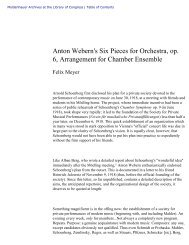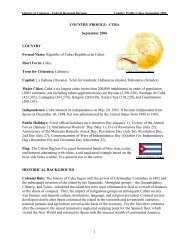1 - American Memory
1 - American Memory
1 - American Memory
You also want an ePaper? Increase the reach of your titles
YUMPU automatically turns print PDFs into web optimized ePapers that Google loves.
17S<br />
analysis would Indicate that visitor spending supports, directly and indirectly,<br />
close to 20 percent of Hawaii's total economy. The visitor industry in Hawaii is of<br />
course completely dependent upon the maintenance of uninterrupted service by<br />
the eight U.S. trunk air carriers that serve Hawaii.<br />
In summary, Hawaii is completely dependent for her economic life on the<br />
movement of commodities to and from the Mainland U.S., mostly by ship but<br />
partly by air, and on the movement of people to and from the Mainland U.S., now<br />
entirely by air.<br />
It is estimated that in 1973 commodities moving to Hawaii from the Mainland<br />
U.S. by ship will amount to 5 million tons and by air to 50,000 tons. Commodity<br />
movement from Hawaii to the Mainland U.S. will be 2 million tons by ship and<br />
2.'>,000 tons by air. With a 1973 population of 823,000, this will mean 8.6 tons per<br />
person per year. This amounts to nearly 35 tons for a family of four.<br />
As far as people are concerned (visitors plus local residents), it is estimated<br />
that in 1973 westbound carriers to Hawaii, most of which are domestic trunk<br />
carriers, will fly 2.3 million people to Hawaii.<br />
It is obvious that without full, uninterrupted service between the Mainland<br />
U.S. and Hawaii, the Hawaiian economy suffers badly, and if the interruption is<br />
long and severe, we suffer drastically. This is documented in the following<br />
chapter.<br />
CHAPTER II—TRANSPOETATION STRIKES AND THEIR IMPACT ON HAWAII<br />
Over the past several decades, there have been hundreds of interruptions of<br />
shipping and air transportation between Hawaii and the Mainland U.S. Not<br />
merely a severe inconvenience and strain for Hawaii's consumers and business-<br />
men, these interruptions have caused untold economic los-ses throughout the<br />
State.<br />
Since World War II, more than four years' time has been lost through trans-<br />
portation strikes affecting Hawaii. Eight major strikes, only one centered In<br />
Hawaii, accounted for 637 of the lost days. They were:<br />
1. The 53-day West Coast shipboard union strike In 1946.<br />
2. The 96-day West Coast shipboard union strike in 1948.<br />
3. The 177-day Hawaii longshoremen's strike in 1949.<br />
4. The 66-day West Coast sailors' strike in 1952.<br />
5. The 27-day West Coast shipboard union strike In 1962.<br />
6. The 43-day machinists' strike of five trunk air carriers in 1966.<br />
7. The 134-day West Coa.st longshoremen's strike In 1971-72.<br />
8. The 41-day West Coast ship officers' strike In 1972.<br />
Some of the scores of shorter or less damaging strikes which cost over a thou-<br />
sand more lost days are listed In the Appendix.<br />
In addition to this cumulative total of over four years of Interrupted trans-<br />
portation to and from Hawaii, there Is the prestrike period of frantic stock-<br />
piling and the poststrike period of getting bu.slness back to normal. The cumula-<br />
tive total time of disruption due to transportation disputes may therefore well<br />
be in the range of six years since World War II—or nearly one-fourth of the<br />
time.<br />
The 1W9 strike of Hawaii's dockworkers was not only the longest, but the<br />
most severe. Because local docks were closed to all but military ships, virtually<br />
all of our oceanbojne conunerce was completely cut off.<br />
But no one can say that a strike centered on the Mainland has much lees of<br />
an Impact on Hawaii. The great bulk of our commerce is with the Mainland<br />
states, primarily through West Coast ports. Although this two-way trade tra-<br />
verses thousands of miles of international waters, it is still considered domestic<br />
commerce and the law requires that It be carried on U.S. flag vessels. (The same<br />
type of regulation applies to air as well as ocean transportation. Passengers,<br />
for example, may not fly from any Mainland U.S. city to Hawaii on a foreign<br />
airline unless their destination Is a foreign city beyond Hawaii.) Except In the<br />
event of a strike involving Hawaii's ports, foreign vessels can keep our com-<br />
merce open with foreign countries. But our foreign commerce Is nothing com-<br />
pared to our dependence on trade with the Mainland, and foreign vessels can<br />
do nothing to restore that.<br />
Let's take a look at some of the most devastating transportation interruptions<br />
that have hit Hawaii in the past 24 years.<br />
97-548 O - 74 - la



![Albert Einstein Papers [finding aid]. Library of Congress. [PDF ...](https://img.yumpu.com/21604228/1/190x245/albert-einstein-papers-finding-aid-library-of-congress-pdf-.jpg?quality=85)





![American Colony in Jerusalem Collection [finding aid]. Library of ...](https://img.yumpu.com/17941275/1/190x245/american-colony-in-jerusalem-collection-finding-aid-library-of-.jpg?quality=85)



![Piccard Family Papers [finding aid]. - American Memory - Library of ...](https://img.yumpu.com/17941234/1/190x245/piccard-family-papers-finding-aid-american-memory-library-of-.jpg?quality=85)


